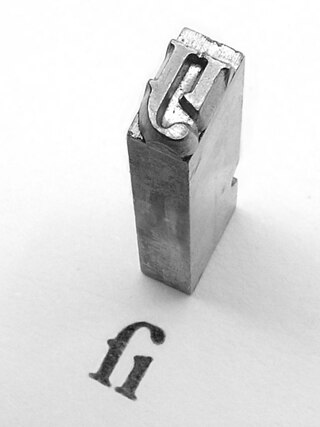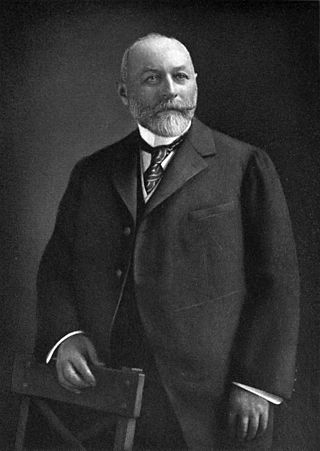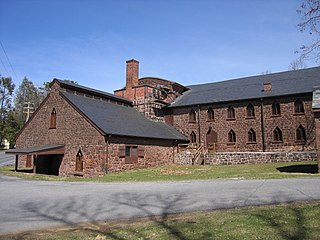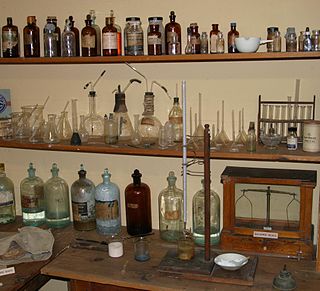
Sulfur (also spelled sulphur in British English) is a chemical element with the symbol S and atomic number 16. It is abundant, multivalent and nonmetallic. Under normal conditions, sulfur atoms form cyclic octatomic molecules with a chemical formula S8. Elemental sulfur is a bright yellow, crystalline solid at room temperature.

Sulphur is a city in Calcasieu Parish, Louisiana, United States. The population was 21,809 in 2020. Sulphur is part of the Lake Charles metropolitan statistical area.

Port Sulphur is a census-designated place (CDP) on the West Bank of the Mississippi River in Plaquemines Parish, Louisiana, United States; at the 2020 census, it had a population of 1,677.

In printing, type metal refers to the metal alloys used in traditional typefounding and hot metal typesetting. Historically, type metal was an alloy of lead, tin and antimony in different proportions depending on the application, be it individual character mechanical casting for hand setting, mechanical line casting or individual character mechanical typesetting and stereo plate casting. The proportions used are in the range: lead 50‒86%, antimony 11‒30% and tin 3‒20%. Antimony and tin are added to lead for durability while reducing the difference between the coefficients of expansion of the matrix and the alloy. Apart from durability, the general requirements for type-metal are that it should produce a true and sharp cast, and retain correct dimensions and form after cooling down. It should also be easy to cast, at reasonable low melting temperature, iron should not dissolve in the molten metal, and mould and nozzles should stay clean and easy to maintain. Today, Monotype machines can utilize a wide range of different alloys. Mechanical linecasting equipment uses alloys that are close to eutectic.

The Frasch process is a method to extract sulfur from underground deposits by taking advantage of low melting point of sulfur. It is the only industrial method of recovering sulfur from elemental deposits. Most of the world's sulfur was obtained this way until the late 20th century, when sulfur recovered from petroleum and gas sources became more commonplace.

Puddling is the process of converting pig iron to bar (wrought) iron in a coal fired reverberatory furnace. It was developed in England during the 1780s. The molten pig iron was stirred in a reverberatory furnace, in an oxidizing environment to burn the carbon, resulting in wrought iron. It was one of the most important processes for making the first appreciable volumes of valuable and useful bar iron without the use of charcoal. Eventually, the furnace would be used to make small quantities of specialty steels.

Herman Frasch [or Hermann Frasch] was a chemist, mining engineer and inventor known for his work with petroleum and sulfur.

Aluminium recycling is the process by which scrap aluminium can be reused in products after its initial production. The process involves simply re-melting the metal, which is far less expensive and energy-intensive than creating new aluminium through the electrolysis of aluminium oxide, which must first be mined from bauxite ore and then refined into aluminium oxide using the Bayer process and then refined again into aluminium metal using the Hall–Héroult process.

Cornwall Iron Furnace is a designated National Historic Landmark that is administered by the Pennsylvania Historical and Museum Commission in Cornwall, Lebanon County, Pennsylvania in the United States. The furnace was a leading Pennsylvania iron producer from 1742 until it was shut down in 1883. The furnaces, support buildings and surrounding community have been preserved as a historical site and museum, providing a glimpse into Lebanon County's industrial past. The site is the only intact charcoal-burning iron blast furnace in its original plantation in the western hemisphere. Established by Peter Grubb in 1742, Cornwall Furnace was operated during the Revolution by his sons Curtis and Peter Jr. who were major arms providers to George Washington. Robert Coleman acquired Cornwall Furnace after the Revolution and became Pennsylvania's first millionaire. Ownership of the furnace and its surroundings was transferred to the Commonwealth of Pennsylvania in 1932.
Liquation is a metallurgical method for separating metals from an ore or alloy. The material must be heated until one of the metals starts to melt and drain away from the other and can be collected. This method was largely used to remove lead containing silver from copper, but it can also be used to remove antimony from ore minerals, and refine tin.

A cupola or cupola furnace is a melting device used in foundries that can be used to melt cast iron, Ni-resist iron and some bronzes. The cupola can be made almost any practical size. The size of a cupola is expressed in diameters and can range from 1.5 to 13 feet. The overall shape is cylindrical and the equipment is arranged vertically, usually supported by four legs. The overall look is similar to a large smokestack.
Metals and metal working had been known to the people of modern Italy since the Bronze Age. By 53 BC, Rome had expanded to control an immense expanse of the Mediterranean. This included Italy and its islands, Spain, Macedonia, Africa, Asia Minor, Syria and Greece; by the end of the Emperor Trajan's reign, the Roman Empire had grown further to encompass parts of Britain, Egypt, all of modern Germany west of the Rhine, Dacia, Noricum, Judea, Armenia, Illyria, and Thrace. As the empire grew, so did its need for metals.

A metallurgical assay is a compositional analysis of an ore, metal, or alloy, usually performed in order to test for purity or quality.
Carusu is the Sicilian word for "boy" and is derived from the Latin carus which means "dear" In the mid-1800s through the early 1900s in Sicily, carusu was used to denote a "mine-boy", a labourer in a sulfur, salt or potash mine who worked next to a picuneri or pick-man, and carried raw ore from deep in the mine to the surface. As with other mining industries, the use of carusi declined as mines switched to other, more efficient methods of transporting minerals to the surface, and the use of children is said to have ended by the 1920s or 1930s, but teenagers were still employed to carry ore to the surface as late as the 1950s.

Plants for the production of lead are generally referred to as lead smelters. Primary lead production begins with sintering. Concentrated lead ore is fed into a sintering machine with iron, silica, limestone fluxes, coke, soda ash, pyrite, zinc, caustics or pollution control particulates. Smelting uses suitable reducing substances that will combine with those oxidizing elements to free the metal. Reduction is the final, high-temperature step in smelting. It is here that the oxide becomes the elemental metal. A reducing environment pulls the final oxygen atoms from the raw metal.

The Union Sulphur Company was an American sulfur mining corporation founded in 1896 by the famous inventor Herman Frasch. It utilized the Frasch Process to extract previously inaccessible sulfur deposits located beneath swampland in Louisiana. The Union Sulphur Company dominated the world sulfur market until its patents expired in 1908. Its success led to the development of the present-day city of Sulphur, Louisiana. After its sulfur patents expired, the company transitioned into oil and natural gas production and was renamed the Union Sulphur & Oil Company and later the Union Oil & Gas Corporation.
The geology of Sicily records the collision of the Eurasian and the African plates during westward-dipping subduction of the African slab since late Oligocene. Major tectonic units are the Hyblean foreland, the Gela foredeep, the Apenninic-Maghrebian orogen, and the Calabrian Arc. The orogen represents a fold-thrust belt that folds Mesozoic carbonates, while a major volcanic unit is found in an eastern portion of the island. The collision of Africa and Eurasia is a retreating subduction system, such that the descending Africa is falling away from Eurasia, and Eurasia extends and fills the space as the African plate falls into the mantle, resulting in volcanic activity in Sicily and the formation of Tyrrhenian slab to the north.

The Texas Gulf Sulphur Company was one of the largest sulfur mining companies in the world from 1919 to 1981. By 1925 the company controlled 40% of the U.S. sulfur market. It was formed in 1909 and acquired in 1981, after expanding across the United States from Texas into Mexico, Canada, and Ethiopia.

The Sulphur Crisis of 1840 was a conflict between the Kingdom of the Two Sicilies and the United Kingdom. In the 19th century, the Kingdom of the Two Sicilies maintained a large sulphur mining industry and was responsible for most of the world's production. In industrialising, British demand for sulphur increased considerably. The nation had a very favourable treaty with the Two Sicilies, negotiated in 1816. The Sulphur Crisis of 1840 occurred when King Ferdinand II gave a monopoly of the sulphur industry to a French firm. The British argued it violated the 1816 trade agreement. A peaceful solution was eventually negotiated by France.

Sulfur was one of Sicily's most important mineral resources, which is no longer exploited. The area covered by the large deposits is the central area of the island and lies between the provinces of Caltanissetta, Enna and Agrigento: The area is also known to geologists as the chalky-sulfur plateau. But the area of mining exploitation also extended as far as the Province of Palermo with the Lercara Friddi basin and the Province of Catania, of which a part of the Province of Enna was part until 1928; it is the one in which sulfur mining, processing and transport took place in the last quarter of the millennium. For a time it also represented the maximum production area worldwide.



















